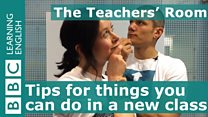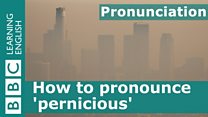Unit 10: English You Need
Exams, news, pronunciation, teachers' tips, learners' questions
Select a unit
- 1 English You Need
- 2 English You Need
- 3 English You Need
- 4 English You Need
- 5 English You Need
- 6 English You Need
- 7 English You Need
- 8 English You Need
- 9 English You Need
- 10 English You Need
- 11 English You Need
- 12 English You Need
- 13 English You Need
- 14 English You Need
- 15 English You Need
- 16 English You Need
- 17 English You Need
- 18 English You Need
- 19 English You Need
- 20 English You Need
- 21 English You Need
- 22 English You Need
- 23 English You Need
- 24 English You Need
- 25 English You Need
- 26 English You Need
- 27 English You Need
- 28 English You Need
- 29 English You Need
- 30 English You Need
Session 4
Welcome to The Teachers’ Room. The show all about teaching practice. Grab a cup of coffee, pull up an armchair and relax. Learn something new, remember something fundamental or just have a giggle.
Activity 1
The Teachers' Room
Dictation activities part 1
Dan and Sian discuss three ways to make dictation enjoyable for students
Watch the video and complete the activity

___________________________________________________________________
Did you like that? Why not try these?
____________________________________________________________________________________
Dictation activities part 1
Dictactions have been a part of the EFL teacher's arsenal since teaching began! They are a great way of getting students to utilise multiple language skills: listening, reading, writing, speaking, pronunciation, grammar and vocabulary understanding...it's all there! And the good news is: dictation doesn't have to be boring!
What's the point?
Dictations can be used to communicate a longer text for a following reading activity. They can be used to distribute sentences for error correction. They can be used to set up a gap fill activity by dictating the sentences to be completed. Whatever you choose to use a dictation for, bear in mind the activity and set up your dictation accordingly.
Running dictation
Take your chosen material and display it somewhere away from the class, e.g. the school corridor. Divide the students into pairs or small groups. One student is the messenger - their job is to go to the text, memorise an item or section, return to the group and communicate what they remember (they may need multiple trips). The other student is the scribe - their job is to listen to the messenger and accurately record the information. Once the first item or section has been completed, the students swap roles and go again. Be careful! While it is called a running dictation, be mindful of students racing around corners and running into each other... better to tell them to walk quickly!
Shouting dictation
This is a great activity for teaching students to communicate in noisy areas, such as at a party! It also encourages shy students to really get involved. Place students at opposite ends of a room or corridor with a split text - student A has half of the information; student B has the other half. Get the students to shout in order to swap information so that both have the completed text. Encourage them to be noisy! Remember to get each pair to start at a different place in the text or all the student As will be shouting the same information at the same time - in which case, listening won't be much of a challenge for the student Bs.
To do
Try our quiz to see if you've picked up our tips.
The Teachers' Room Quiz
5 Questions
Check what you've learned about dictation activities by selecting the correct answer to each question.
Help
Activity
Check what you've learned about dictation activities by selecting the correct answer to each question.
Hint
What does dictation require students to do? What skills practice can they get from this?Question 1 of 5
Help
Activity
Check what you've learned about dictation activities by selecting the correct answer to each question.
Hint
Someone has to relay the message; another person has to record it.Question 2 of 5
Help
Activity
Check what you've learned about dictation activities by selecting the correct answer to each question.
Hint
What happens if you get lots of people running around in a small space?Question 3 of 5
Help
Activity
Check what you've learned about dictation activities by selecting the correct answer to each question.
Hint
Where and why might people need to shout?Question 4 of 5
Help
Activity
Check what you've learned about dictation activities by selecting the correct answer to each question.
Hint
You are likely to have lots of A-B pairs of students. All the As have the same information and all the Bs have the same information. As a result, any A can inform any B. Why is this a problem?Question 5 of 5
Excellent! Great job! Bad luck! You scored:
Get involved
Well, those were just a few ideas that we here at BBC Learning English had, but we know that you teachers out there have lots of fantastic ideas too, and we’d like you to share them with us and everybody else.
If you have a great tip or technique for teaching dictation, or anything else, please email us at learningenglish@bbc.co.uk. Your email could be posted here on this page, or may even be mentioned in our show.
We are also looking for video tips to include in the programme. In order to do this, please include whether or not you’d like to be included for video with your tip, and we'll get in touch with you.
End of Session 4
Next up is Learners' Questions. Abdalla from Egypt wants to know the difference between ‘let’s go’ and ‘it’s high time we went’, and asks why the past tense is used after ‘its high time’. Dan's here with the answer! Join us in Session 5 to find out.
Session Vocabulary
Dictation activities part 1
- Dictation is a very useful ELT tool
- Think about the point of the activity
- Running dictation
- Shouting dictation


